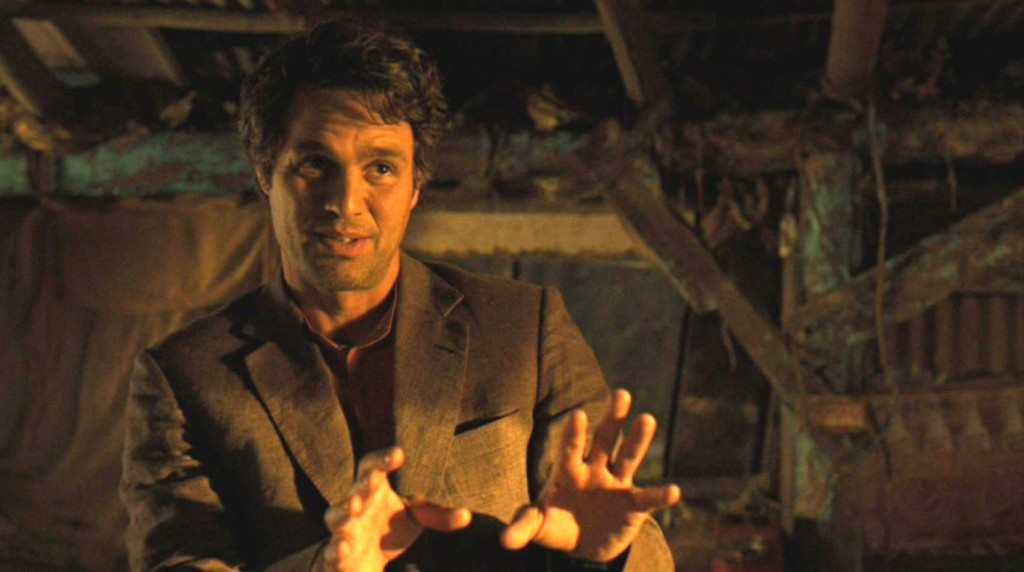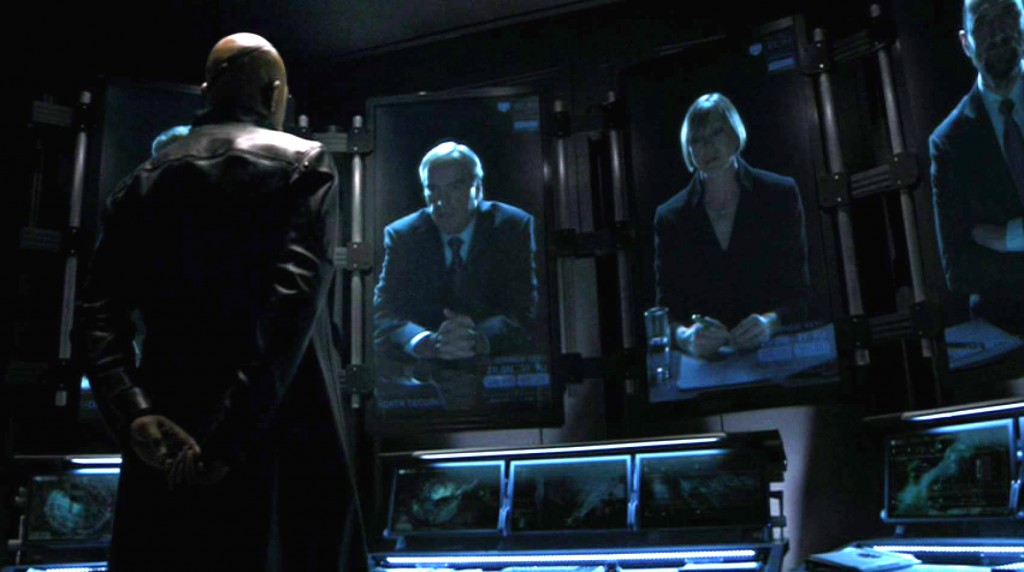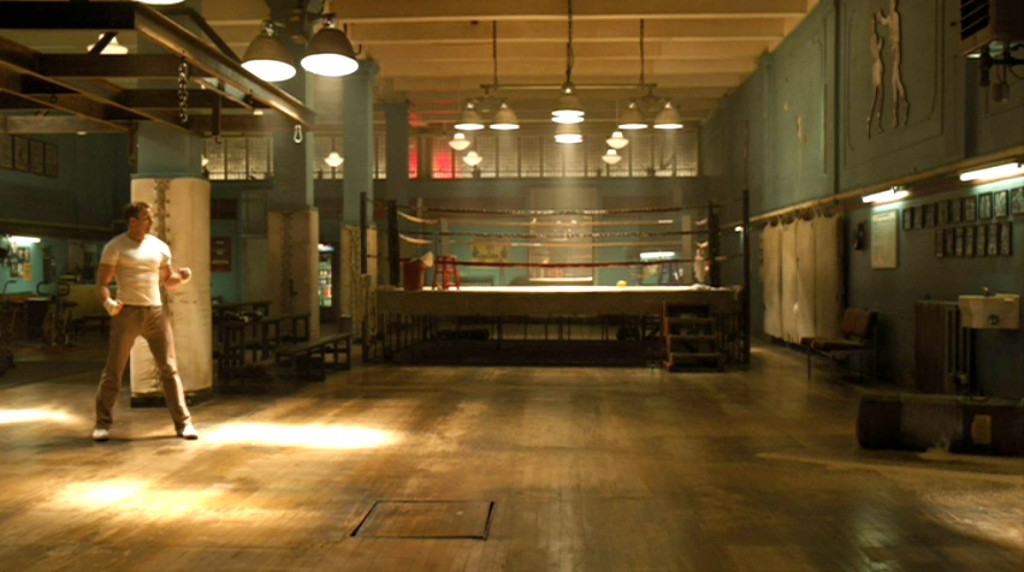The Avengers part 5
We now scoot over to India, where we meet Bruce Banner. Or rather, first we meet a little Indian girl, who dashes through a slum in search of Dr. Banner to aid her dying father. The little girl’s desperation is palpable, and the good doctor can hardly help but follow her. Our hearts go out to the little girl, and we desperately want to see Dr. Banner help her father. Like everything in The Avengers, this is played out very quickly but with great efficiency. A little drama is created, as our protagonist shifts from Nick Fury to Black Widow to this little girl on her mission to save her father. And, because the direction is so sure and the production design so convincing, we accept the truth and stakes of the girl’s plight.
The little girl, it turns out, is bait, set by Black Widow to capture Bruce. The little girl, in her helplessness, plays on Bruce’s good nature and feelings of sympathy and gets him to go to an empty house. There’s a wonderful moment just before they get to the house where the police roll by and Bruce shields the little girl with his body, as though keeping her out of the hands of the authorities. He is, of course, keeping himself out of the hands of the authorities, but he plays the moment for the sake of the girl, as “the caring father.”
Kurt Vonnegut once said “We are what we pretend to be, so we must be very careful what we pretend to be.” This applies to no one in the comics universe more than Bruce Banner, who must be very careful indeed what he pretends to be. His life as a doctor is, in its way, a performance, or an act of contrition, a way to pay for the things he does as “the other guy.”
When the little girl leaves Bruce like a groom at the altar, we realize: the little girl isn’t just like Black Widow, she is Black Widow, using the patented Black Widow technique of getting men to let their guard down by putting on a weak-and-helpless act.
What does Black Widow want? Black Widow wants to get Bruce to help look for the Tesseract. A murmuring of “gamma radiation” suffices as a reason why it absolutely must be a radically unstable monster who is brought in to help look for the Tesseract.
The shift from Fury to Black Widow (actually from Fury to Coulson to Black Widow) keeps the narrative jumping. If it were any one person going from door to door looking for heroes, the laundry-list problem might again assert itself. (See the opening of Ocean’s 12 for an example of this.)
The action of the scene is simple: Black Widow wants Bruce to come with her and Bruce doesn’t want to go. Yet the scene is comparatively leisurely, and, since we already know that Black Widow is a master manipulator of men’s desires, her skill in the negotiations isn’t new. What is left is character work, a “getting to know Bruce Banner” scene. The performances are warm, detailed and canny, and it’s almost a love scene, where the lovers dance around not the subject of attraction but the subject of Bruce’s gigantic green alter ego. They dance around it so much that Bruce finally threatens to let it out, just as a tease, just “to see what you’d do.” What Black Widow would do is instantly pull a gun, the love scene over, the dance done. The Avengers is, in many ways, a cautious love story with multiple partners, the question being, can our love outlive our conflicts, can it outlive our flaws?
Now we check back in with Nick Fury, who, it turns out, is answerable to some sort of council. The council, like all councils, wants to rein in the wild-card Fury, to control him, much like Bruce Banner needs to control his own fury. I mentioned before that Nick Fury’s goal is the same as the writer-director’s. If that’s true, then this council is the movie studio. The world is at stake and the council, like the movie studio, wants to go with the safe bet, a “Phase Two” program we’ve heard mentioned in passing. But Fury wants, instead, to take this crisis as an opportunity to build a family, to not just assemble a team of soldiers but to become their father, exactly in the way a director becomes a father to his crew. And, as on a film shoot, romances bloom, friendships are struck, fights are had, and eventually the job gets done.
When Fury talks about assembling the Avengers he talks about them like they’re a group of unruly foster kids he wants to build into a little-league team. He cares about them, even as he knows he may be sending them to their deaths. It’s like he’s using Loki’s threat as an excuse to spend time with his estranged children.
Nick Fury goes to find Steve Rogers, who’s recently been woken from a seventy-year coma. What does Steve Rogers want? Steve is a patriot, an unreconstituted gung-ho soldier, literally frozen in his time, a time when the US was the beacon of the world.
And so, for a moment, The Avengers takes on a political dimension, as the frozen soldier confronts a present where the US is decidedly not the beacon of the world. The present takes the form of Fury, who, with his leather trenchcoat and eyepatch, looks more like the Gestapo he fought in WWII than an American soldier. He can’t trust Fury, partly because of his darkness and cynicism, and partly because Fury represents ideas so strange they would be hard for anyone to understand, ideas like alien artifacts, parallel dimensions and gods among men.
Fury lives with this stuff, and it wears on him — no one should have to deal with the kind of bizarre he sees every day. Steve, of course, knows about the Tesseract, because the Tesseract was the Maguffin of his movie too, much better plot placement than a half-hearted mention of gamma radiation. The screenplay slowly, slowly teases out information on the Tessaract in order to avoid what we screenwriters call an “information dump.” The exposition is parceled out a line or two at a time, keeping the emphasis on character interaction — it’s not “What happens if Loki has the Tessaract?” but “How will Steve Rogers ever trust Nick Fury?” The former is already settled, we know The Avengers will succeed, we’re paying money to watch them succeed, but the latter, “Will everyone learn to get along?” is where the real meat of the movie lies.



Todd, I think you mean Steve Rogers.
Thank you. Too many superheroes.
I haven’t seen it since it was in the theaters, but I’m struck by the parallelism in these recruitment scenes (as well as the parallel between Nick-shadowy council and Bigrobe-celestial jukebox). Structurally, it’s something like
hero–enemy environment–refusal/acceptance
So we see Romanov unleash her destructive power against her proximate problem, while Banner has to restrain his power, even though it would be pretty easy for him to destroy his proximate problem (the recruiting party). But where Romanov and Banner are surrounded by thugs/soldiers, Steve Rogers’s enemies turn out to be nothing at all–he’s haunted by an absence of enemy. (Not even the punching bags can stand up to him.) Just look at how empty his gym is, how haunted, how old-fashioned.
This structure may break down when you look at Coulson recruiting Stark–unless you think that Iron Man’s first enemy is Tony Stark and his self-centered hedonism…
Yes. Thank you.
Of course, all superhero narratives are, as I’ve noted elsewhere, power fantasies. Make the fantasy too literal and it’s no longer a superhero movie, it’s just a crime drama or something. But the power hierarchies in The Avengers are so complicated they cannot help but comment on one another.
One of the very interesting things about “the council” is that it must exist at a level above that of the US Government–unless one of the members is the president, there is a discussion of nuking the US that doesn’t seem to involve the oval office.
Now, (a) maybe I missed something, (b) SHIELD is probably supposed to be global in SOME version of the Marvel comics–but would Captain America work for them then? I dunno–but (c) I think the real reason is that having a white guy stand-in for the president would make the viewers go “Uh … isn’t it Obama” and having a black guy stand in for the real Obama would wind up making some kind of political statement that the movie was probably reluctant to make.
So we get this group that appears to just be about managing super heroes and super tech–but then, later, is authorizing nuclear strikes on US cities and we just go “Oh, okay …”
I’m super not up on my SHIELD mythology, but I didn’t get the impression that Fury is addressing world leaders. The council has a more “shadowy cabal” feeling about them.